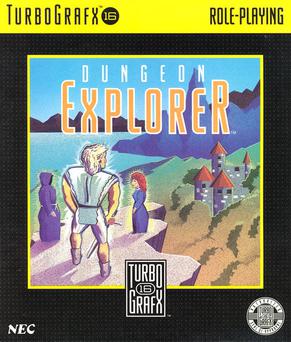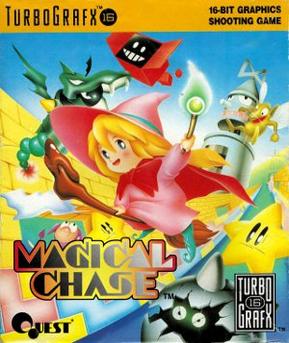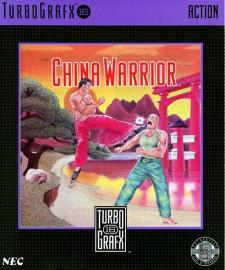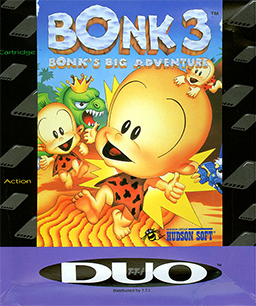Bonk, known as PC-Genjin in Japan and as PC Kid or B.C. Kid in PAL territories, is a video game character and former mascot for NEC's PC Engine/TurboGrafx-16 video game console. Three platform games featuring the character appeared on the PC Engine/TurboGrafx-16, as well as two spin-offs featuring Air Zonk. The protagonist is a bald caveman named Bonk who attacks using his comically large head.

Military Madness is a 1989 turn-based strategy video game originally developed and published by Hudson Soft in Japan and NEC in North America for the TurboGrafx-16. It is the first entry in the Nectaris series. Set in the year 2089, players take command of the Allied-Union forces in a desperate offense against the Axis-Xenon Empire army on the Moon before they launch the S.A.M. weapon to obliterate Earth. Its gameplay consists of moving units into positions to confront enemies in turn-based encounters determined by multiple factors, capturing factories to produce resources and repair units in order to occupy the enemy prison camp or destroy all enemy forces.
The Virtual Console is a defunct line of downloadable video games for Nintendo's Wii and Wii U home video game consoles and the Nintendo 3DS family of systems.

Dungeon Explorer is an action role-playing video game developed by Atlus for the TurboGrafx-16 and originally published by Hudson Soft in Japan on March 4, 1989, and later in North America by NEC on November 15 of the same year. The first installment in the eponymous franchise, the game is set in the land of Oddesia, which has been overrun by an alien race and where players assume the role of one of eight main characters tasked with recovering the Ora stone to kill the alien king Natas. Co-directed by Kazutoshi Ueda and Yōsuke Niino, the title was created by most of the same team that would work on later several projects such as entries in the Megami Tensei series. Though it was initially launched for the TurboGrafx-16, it was later re-released through download services for various consoles.

Magical Chase is a 1991 horizontally scrolling shooter video game developed by Quest and published by Palsoft and Turbo Technologies Inc. for the TurboGrafx-16. The game stars a young witch apprentice named Ripple, who broke a promise to her teacher by accidentally releasing six demons from a forbidden book, joined by her star companions Topsy and Turvy on a quest to catch and seal the demons back into the book.

Alien Crush is a pinball video game developed by Compile for the PC Engine/TurboGrafx-16. It was released in 1988. The game is the first installment in the Crush Pinball series. It was followed by three sequels, Devil's Crush, Jaki Crush, and Alien Crush Returns. Alien Crush was later re-released via emulation on the Virtual Console for Wii, 3DS, and Wii U, and for PlayStation 3 through PlayStation Network.

Neutopia II is a 1991 action-adventure/action role-playing video game developed and published in Japan by Hudson Soft and in North America by Turbo Technologies for the TurboGrafx-16. It is the sequel to Neutopia, which was released earlier in 1989. In the game, the player takes control of Jazeta's son, who embarks on a quest to both save his father and defeat the returning evil demon Dirth.

Valis III is a 1990 action-platform video game originally developed by Laser Soft, published by Telenet Japan and NEC for the TurboGrafx-CD. A Sega Genesis version was released in 1991. It is the third entry in the Valis series. It stars Yuko Asou, a Japanese teenage schoolgirl chosen as the Valis warrior and wielder of the mystical Valis sword after the events of Valis II. King Glames, wielder of the sword Leethus, leads denizens of the dark world to conquer both Vecanti and Earth, seeking refuge for his people amid the destruction of their planet. Together with the demon warrior-maiden Cham and her sister Valna, Yuko must prevent Glames from destroying both worlds. Through the journey, the player explores and searches for items and power-ups while fighting enemies and defeating bosses.

China Warrior, known as The Kung Fu in Japan, is a beat 'em up video game created in 1987 by Hudson Soft for the PC Engine/TurboGrafx-16. The game received mixed reviews upon release, with praise for its large sprite graphics but criticism towards its gameplay.

Gunhed, known as Blazing Lazers in North America, is a vertically scrolling shooter game by Hudson Soft and Compile, based on the Japanese film Gunhed. The title was released in 1989, for the PC Engine in Japan and re-skinned for the TurboGrafx-16 in North America, with Gunhed unofficially imported for the PC Engine in Europe. In the game, a fictional galaxy is under attack by an enemy space armada called the Dark Squadron, and this galaxy's only chance for survival is the Gunhed Advanced Star Fighter, who must destroy the Dark Squadron and its Super Weapons. The gameplay features fast vertical scrolling and a wide array of weapons for the player to use.

Valis II is a 1989 action-platform video game originally developed by Laser Soft, published by Telenet Japan and NEC for the PC Engine CD-ROM²/TurboGrafx-CD. A home computer version was released for PC-8801, MSX2, PC-9801 and X68000. A super deformed-style remake was also released in 1992 for the Sega Mega Drive/Genesis. It is the second entry in the eponymous series. It stars Yuko Asou, a Japanese schoolgirl teenager chosen to become the Valis warrior by wielding the titular mystical sword, after defeating the demon lord Rogles. The dream world Vecanti fell under the rule of emperor Megas, whose hatred towards his brother Rogles and bloodthirsty tendencies seeks to wipe out traces of the former tyrant, including his supporters. Gameplay varies between each version but all share similar elements, as the player explores and search for items and power-ups, while fighting enemies and defeat bosses.

Chew Man Fu is a 1990 action video game developed by Now Production and published in Japan by Hudson Soft and in North America by NEC for the TurboGrafx-16.

Bonk 3: Bonk's Big Adventure is an action video game released for the TurboGrafx-16 in 1993, the third game in the Bonk video game series.

Bomberman, also known as Dyna Blaster in Europe, is an action-maze video game originally developed and published by Hudson Soft for the PC Engine in Japan on 7 December 1990 and later in North America for the TurboGrafx-16 by NEC in 1991. Belonging to the Bomberman franchise, it is a re-imagining of the first game in the series starring White Bomberman on a quest to rescue Lisa, the kidnapped daughter of his inventor Dr. Mitsumori, from the castle of Black Bomberman while defeating evil monsters and villains that work for him. The game was later ported to home computers, each one featuring changes compared to the original version. Conversions for other platforms were in development but never released. The title garnered positive reception from critics since its initial release on the PC Engine/TurboGrafx-16 and later on home computers.

Gate of Thunder is a 1992 scrolling shooter video game developed by Red Company and published by Hudson Soft for the TurboGrafx-CD. It was the first game released in North America to support the Super CD-ROM² format and served as one of the pack-in games for the TurboDuo, a two-in-one system which runs both TurboGrafx-CD and TurboGrafx-16 titles, where it was bundled with Bonk's Adventure, Bonk's Revenge and Bomberman on the same disc. In the game, the player controls the Hunting Dog space fighter craft, piloted by space cop Hawk. Alongside his ally Esty, piloting the Wild Cat support ship, Hawk must stop General Don Jingi and his Obellon armada from obtaining the powerful "Starlight" energy source from planet Aries.

Lords of Thunder is a horizontally scrolling shooter developed by Red Company and published in 1993 by Turbo Technologies and Hudson Soft for the TurboDuo. It is the unofficial follow-up to Gate of Thunder. The player controls the knight Landis, donning the armor of his ancestor Drak on a confrontation against Zaggart of Garuda Empire, who resurrected the evil god Deoric, and his six dark generals across the land of Mistral.

Cyber Core is a 1990 vertically scrolling shooter video game developed by Alfa System and published in Japan by Information Global Service (IGS) and in North America by NEC for the TurboGrafx-16. Set in the year 2269 where Earth has been overrun by an alien race known as Hyper Insects, the player controls a Chimera bio-fighter craft, piloted by the enforcer Rad Ralph in order to fend off the invaders and reclaim the planet. Similar to Dragon Spirit, Ralph has a projectile weapon for destroying air-based enemies and a bomb for destroying ground-based enemies.

Seirei Senshi Spriggan is a 1991 vertically scrolling shooter video game developed by Compile and published by Naxat Soft in Japan for the PC Engine CD-ROM². In the game, the player assume control of Jega and Rikart piloting the Spriggan in order to protect their country from the Buraizubara empire.

Rayxanber III is a 1992 scrolling shooter video game developed and published by Data West for the PC Engine Super CD-ROM². It is a follow-up to Rayxanber II, which was released earlier in 1991 for the PC Engine CD-ROM², and the last entry in the Rayxanber trilogy. In the game, the player assumes the role of a fighter pilot controlling the ES3 Donner Kyle space craft deployed into the homeworld of the Zoul Empire, in retaliation for the destruction of a mother ship from Earth. It retains the same gameplay as its predecessors, with the players fighting against an assortment of enemy forces while avoiding collision with their projectiles and other obstacles.

King of Casino is a 1990 gambling simulation video game developed by Algorithm Institute, published in Japan by Victor Musical Industries and in North America by NEC for the TurboGrafx-16. The game sees the players go to different casinos with $10000, using the money to participate in poker, blackjack, roulette, slot machines and keno, in order to win $10 million. After selecting one of the three playing modes, there are 15 casinos with slight differences to choose on a town map. Inside the casino the games itself are started by clicking on one of the gambling tables. It received generally favourable reception from critics, most of which reviewed it as an import title.



















